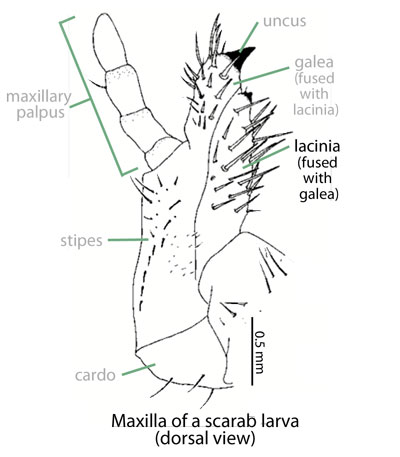Native
none known
Family: Lucanidae Subfamily: Lucaninae Genus: Figulus Species: Figulus integricollis Thomson, 1862
none available
Total body length 11.0–22.0 mm (0.43–0.87 in) including mandiblesmandibles:
The crushing or chewing portion of an insects mouthparts
 . Body shape elongate oval; dorsoventrally flattened. Color shiny black. Ocular canthuscanthus:
. Body shape elongate oval; dorsoventrally flattened. Color shiny black. Ocular canthuscanthus:
a process extending over and sometimes dividing the eye
completely dividing eye. MandiblesMandibles:
The crushing or chewing portion of an insects mouthparts
 prominent; not sexually dimorphicdimorphic:
prominent; not sexually dimorphicdimorphic:
occuring in two distinct forms
. Pronotumpronotum:
the dorsal surface of the thorax
 smooth; often with tubercletubercle:
smooth; often with tubercletubercle:
a small, conical knob or horn-like protuberance
at anterioranterior:
the front or forward; opposite of posterior
border at middle. ElytraElytra:
the hardened and chitinous wing-cover of a beetle that protect and overlie the flight wing
with prominent striaestriae:
a longitudinal depressed line or furrow, often formed from numerous punctures that extends the length of an elytron
 .
.
Undescribed. For Lucanidae (Ritcher, 1966Ritcher, 1966:
Ritcher P. 1966. White grubs and their allies: a study of North American scarabaeoid larvae. Oregon State University Monographs, Studies in Entomology 4: 1-219.): Grub C-shaped, not hump-backed, cylindrical, whitish. Antennaantenna:
paired sensory organ on head, formed from numerous segments
 3 or 4 segmented. Last antennal segment much reduced in size. Maxillamaxilla:
3 or 4 segmented. Last antennal segment much reduced in size. Maxillamaxilla:
set of paired mouthparts located posterior to the mandibles
with galeagalea:
outer branch or lobe of the maxilla
 and lacinialacinia:
and lacinialacinia:
inner portion of the maxilla distinctly separated; maxillary stridulatory teeth absent. Epipharynxepipharynx:
distinctly separated; maxillary stridulatory teeth absent. Epipharynxepipharynx:
lobe on the interior surface of the labrum or clypeus
with united tormaetormae:
in scarab larvae, sclerotized structures on the ends of the clypeolateral suture extending towards the mesal line
. Anal opening Y-shaped.
Guam and the Marianas: This species is recorded from Guam and the Northern Marianas Islands of Farallon de Medinilla, Rota, and Alamagan (Bourquin, 2002Bourquin, 2002:
Bourquin O. 2002. Invertebrates recorded from the Northern Mariana Islands status 2002. CNMI Invertebrate Collection Crees-Northern Marianas College, Saipan.).
Poorly known. LarvaeLarvae:
the immature form of an insect; in scarabs, also called grub or white grub; preceded by the egg stage, followed by the pupal stage
 and adults of the related Australian species Figulus regularis are known to tunnel in dead tree trunks. Dispersing adults may exhibit some host preferences when selecting new logs to colonize, and they have been recorded from trunks of Angophora bakeri (Hawkeswood, 2014Hawkeswood, 2014:
and adults of the related Australian species Figulus regularis are known to tunnel in dead tree trunks. Dispersing adults may exhibit some host preferences when selecting new logs to colonize, and they have been recorded from trunks of Angophora bakeri (Hawkeswood, 2014Hawkeswood, 2014:
Hawkeswood T. 2014. A new adult host record for Figulus regularis Westwood, 1834 (Coleoptera: Lucanidae). Calodema 345: 1-2. full text (accessed 2015)) and Xanthorrhoea johnsonii (Hawkeswood, 1985Hawkeswood, 1985:
Hawkeswood T. 1985. Host plant record for Figulus regularis Westwood (Coleoptera: Lucanidae). The Coleopterist Bulletin 39: 200. full text (accessed 2015)). LarvaeLarvae:
the immature form of an insect; in scarabs, also called grub or white grub; preceded by the egg stage, followed by the pupal stage
 likely feed on rotting wood. Adults are probably predacious, feeding on small invertebrates similar to the related Figulus binodulus (Mori and Chiba, 2009Mori and Chiba, 2009:
likely feed on rotting wood. Adults are probably predacious, feeding on small invertebrates similar to the related Figulus binodulus (Mori and Chiba, 2009Mori and Chiba, 2009:
Mori H and Chiba S. 2009. Sociality improves larval growth in the stag beetle Figulus binodulus (Coleoptera: Lucanidae). European Journal of Entomology 106: 379-383. full text (accessed 2015)). Limited parental care (observed in F. binodulis) may occur in this species, and significant larval mortality may be due to filial cannibalism (Mori and Chiba, 2009Mori and Chiba, 2009:
Mori H and Chiba S. 2009. Sociality improves larval growth in the stag beetle Figulus binodulus (Coleoptera: Lucanidae). European Journal of Entomology 106: 379-383. full text (accessed 2015)).
None. Adult Figulus spp. are predators and larvaelarvae:
the immature form of an insect; in scarabs, also called grub or white grub; preceded by the egg stage, followed by the pupal stage
 feed upon dead wood. No associations with living plants are known (Mori and Chiba, 2009Mori and Chiba, 2009:
feed upon dead wood. No associations with living plants are known (Mori and Chiba, 2009Mori and Chiba, 2009:
Mori H and Chiba S. 2009. Sociality improves larval growth in the stag beetle Figulus binodulus (Coleoptera: Lucanidae). European Journal of Entomology 106: 379-383. full text (accessed 2015)).
Not established or recorded. There are no records of this species from Hawaii.
Native. This species is a native species in Guam, and it is endemicendemic:
in biogeography, a species that occurs only in a given location
to the Marianas Archipelago (Bourquin, 2002Bourquin, 2002:
Bourquin O. 2002. Invertebrates recorded from the Northern Mariana Islands status 2002. CNMI Invertebrate Collection Crees-Northern Marianas College, Saipan.).
This uncommon species does not appear likely to spread beyond its natural range.
This species is unlikely to be confused with other scarab beetles of Guam or Hawaii. The possibility exists that this species might be confused with exotic bess beetles (Passalidae). They are separated based on head armature (Figulus integricollis lacking horns versus passalids with horn or tubercletubercle:
a small, conical knob or horn-like protuberance
on the central, anterioranterior:
the front or forward; opposite of posterior
portion of the head).
None known
Report your observation of this rare and native Guamanian species at our iNaturalist project.